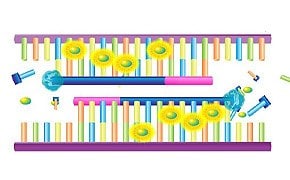定量PCR(qPCR)

定量Real-Time PCR(qPCR)は蛍光レポーター分子を利用して増幅生成物の定量を行います。DNA、cDNA、またはRNAテンプレートを増幅するという点では通常のPCRと同様ですが、この方法では1回のサイクルごとに蛍光シグナルをモニタリングして相対的な、または絶対的な定量を行います。この手法は、遺伝子発現解析、遺伝子型判定(ジェノタイピング)、microRNA解析、遺伝的変異解析、タンパク質解析を含む数多くの分野で有用です。
qPCRデータの解析方法
レポーター分子の蛍光を測定して定量を行います:標準的には、二本鎖DNAの塩基間に挿入する色素(SYBR® Green、臭化エチジウム)、またはDNA上の特定の配列に結合するように設計されたプローブ(Molecular Beacon、TaqMan® プローブ)を使用します。
qPCRデータの相対定量
qPCRデータを使用する定量法は大きくは2つの方法に分かれています。より一般的に使用されている相対定量法では、サンプル内の標的遺伝子の発現または存在量が対照遺伝子が持つ値に対する比率をΔΔCt情報を利用して決定し、参照遺伝子の発現比と照らして規格化します。標的遺伝子と参照遺伝子の効率E値は異なりますから、この方法ではE値の相違についても勘案する必要があります。遺伝子発現解析では、こちらの方法がより頻繁に使用されます。
qPCRデータの絶対定量
2番目の方法である絶対定量法は環境微生物学においてより一般的に使用される手法であり、標準曲線(SC)を利用します。SC法では、既知テンプレート濃度を順次希釈して作成した希釈系列(N0)に線形回帰法を適用して標準曲線[log(N0) vs.CT(閾値サイクル)]を作成します。この曲線を利用してサンプルのテンプレート濃度を計算します。サンプルと標準の効率値と同じであるという知見がこの方法の基礎となっています。
関連技術資料
- After a traditional PCR has been completed, the PCR/qPCR data analysis is conducted by resolution through an agarose gel or, more recently, through a capillary.
- サンプル中の出発物質の量の推定を可能にするリアルタイムPCRは、従来のPCRよりもはるかに広いダイナミックレンジを持ちます。
- PCR assay guide navigates you through primer validation and other assay optimization factors to ensure high sensitivity and specificity for optimum DNA/ RNA quantification.
- 変動性をもたらすさまざまな要因は、PCRのワークフロー全体に影響を及ぼします。サンプルの原料や逆転写ステップの要件など、可変コンポーネントの多くは避けられません。アッセイデザインも変動性が高く、PCRの成否を分けうる要因であると同時に、アッセイの再現性や感度に貢献する要因でもあります。
- The purpose of Hot Start PCR is to inhibit the PCR reaction in order to reduce nonspecific amplification, prevent the formation of primer dimers, and increase product yields.
- すべて表示 (69)
関連プロトコル
- Our SYBR Green qPCR Protocol is a method designed to detect accurate quantification of gene expression and RT-PCR reactions
- Chromatin Immunoprecipitation quantitative real-time PCR (ChIP-qPCR) is commonly used in studies that focus on specific genes and potential regulatory regions across differing experimental conditions and data analysis. qPCR enables DNA analysis in real time by analyzing fluorescent signal intensities that are proportional to the amount of amplicon.
- Primer Concentration Optimization Protocol is an approach to create a matrix of reactions. This is used to test a range of concentrations for each primer against different concentrations of the partner primer.
- Optimization of qPCR conditions is important for the development of a robust assay. The two main approaches are optimization of primer concentration and/or annealing temperatures.
- Multiplex qPCR employing probe-based chemistries is a demanding application that often requires extensive optimization and validation.
- すべて表示 (36)
技術資料・プロトコルの検索
続きを確認するには、ログインするか、新規登録が必要です。
アカウントをお持ちではありませんか?